

Update: interesting news about scientists using an earthquake to date the crucifixion. See Postscript section.
Finding the crucifixion date using astronomy and the new moon worship day approach the Jews would have used in the early years of the first
century to construct their calendar.
Introduction
This study is in a few parts and is here given as a continuation of something started some years ago. As much as this is an investigation
to find the historical crucifixion date it is also an investigation to determine if possible the most likely Biblical new moon worship day.
Finding the crucifixion date would determine just which new moon approach used by the Jews in Jesus' time is most likely to be
the correct one.
Late 2010 I found some curious verses in the Old Testament that led me into an investigation of the Biblical new moon worship
day. Looking at my wall calendar I noticed each month had a new moon day, among other phases, listed. Was this the day?
Searching for more information on the internet I quickly ran into the term "rosh chodesh" which was the Jewish new moon worship day and the
first day of the month for the Jewish calendar. From here things got pretty messy very quickly. Though the Jews claimed to be keeping the
new moon worship day of the Bible they found it by looking for the first sliver of the waxing crescent which brings us into the phase following
the current astronomical new moon.
Further investigation of the Jewish calendar showed that they do not follow this stricly but use a
fixed length construction from new moon to new moon whereas the moon wanders a bit through the year and the lunar synodic month is not exactly
a fixed length but can vary. As a result Jewish calendar new moon days do not strictly occur at the time of the waxing crescent but can
vary a little through the year to the point that some years the Jewish calendar actually gets out of sync with the moon. It is possible
to find Jewish calendar new moon days that actually fall BEFORE the astronomical new moon date!
I decided to do a Bible study to determine if there was any way to sort this muddle out and instead came up with another possible alternative for
the day by taking the construction from the beginning of the dark phase of the moon instead of the waxing crescent which would be at the other
end.
This meant I now had three possible new moon worship days: beginning of dark phase, astronomical, or waxing crescent. Which one was it?
I realised that the only way to come to some sort of conclusion was to obtain some Biblical date that would show which new moon worship day
was most likely to be the correct one. With historical calendars it was pretty obvious that later is better than earlier and the best we could
do would be to find some date at the end of the Bible or in the time of the gospels. The most likely date that has been sought after is
a date for the crucifixion of Christ.
There are some dates suggested for this and there appears to be some diversity in belief on this point. Well I thought it couldn't hurt if I also
had a look at this myself and maybe, just maybe, it might be able to actually resolve this puzzle as which approach is the correct new moon day
of the Bible.
Well the Jews claim it is the waxing crescent so why not just believe that? Their terminology on new moon seems a bit vague especially as you
bring in the concept of a visual sighting with a waxing crescent. Is this the new moon? They claim it is. But the current view of the new moon is
the astronomical version which is completely dark. Who's right? The Jews claim that the command was given to them from God about three and
a half thousand years ago. But the Bible texts in Exodus 12:1,2 really don't say what it is, just that it was the first month of the year.
And the Bible construct for a day starts at sunset, and not at midnight. That is, the dark part of the day comes first. How do you work that
with the moon for a Bible month? Sure the Jews are currently keeping the waxing crescent [in theory] for the start of the month, but did they
always do
that? In the past they obviously observed BOTH the waxing crescent AND the start of the dark phase as this told them the moon would reappear
after about 3 or 4 days. But was the dark phase observation originally for the Bible month and has this been lost in time?
With the destruction of Jerusalem in 70 AD maybe everything changed. Records would have been lost. Could we believe any other historical records
from before this date? The best way to resolve this puzzle is with verification of some date from before this time. Finding a date in the time of
Christ that would verify which new moon was likely to have been used then would solve this puzzle completely.
And so we come to these studies. The original study was attempted some years ago in 2011, probably the early part of the year. It was not
conclusive and after some time I abandoned it. I probably have it somewhere tucked away in some notes but we are going to skip it and proceed to
the more current ones.
So the first study we show here actually started in August 2014. The reasons for restarting this investigation are given in the study. At
this point I was only using one of the new moon models: the beginning of the dark phase of the moon. There are a couple of mistakes in this
study and the date arrived at is most likely wrong. This is commented in the following Historical problems section. Nevertheless most people
should find this study reasonably fascinating and full of all sorts of interesting stuff. Anyone wanting to go to the more correct study can
jump straight to the Historical problems and read from there. For everyone else, enjoy the following...
The restarted study
Well, this is interesting. I just read some curious historical statements from another site about how the Jewish new moon was used in the
calculation of some interesting points of Bible prophecy in the 1800s. And does this put the NT Bible Model into question?
I remember trying
to resolve a very interesting historical point with
the new moon worship day but not doing very well a few years ago. With this historical point from the 1800s it might be a very good idea to
have another look at my earlier attempt.
Anyway it certainly wouldn't hurt. And the most common approach of finding new moon days is the current Jewish view of the waxing crescent
though in all honesty the Jewish calendar doesn't follow this exactly due to the erratic travel of the moon. The length of the lunar synodic
month is variable and not fixed whereas the Jewish calendar uses a fixed length for months and as a result some years gets a bit out of step
with the moon.
2013 was one of these years with half of the Jewish new moon worship days falling on the same day as the
astronomical new moon whereas the waxing crescent is approximately one and a half days later. This may vary but one and a half days is a pretty
good approximation and the method used in the NT Bible Model. Being a common new moon day I may add this to my calendar from 2015 onwards.
But the NT Bible Model is far from dead. And I was very surprised with the historical data I obtained. I haven't got to the data from the 1800s but
it's probably hardly necessary considering what follows. And the fact that the information obtained in the 1800s was based on the current Jewish
new moon approach does not detract from the NT Bible Model at all.
Anyway, let's see what happened. Before getting into the material from the 1800s I decided to have another look at something investigated a few
years ago, without any success. This time the results were different. I decided to look again at the Friday crucifixion date and see if it was workable for
31 AD.
Those following the 2300 day prophecy of Daniel generally arrive at 31 AD as the crucifixion year. Not all Christians agree with this
but it's pretty much where we are at and from what I have read there is some difficulty in obtaining a Friday crucifixion date for this year.
One Christian writer gets there by stretching the period of time from the Astronomical new moon to the waxing crescent to 3 plus days, using a
quote from the Karaite Jews. I have had another look at the article and the writer has definitely made a small mistake. He has taken this time
to be from the time of the astronomical new moon when it is clearly from the beginning of the phase. That does make a small difference.
Anyway I wouldn't blame the writer of the article as this is a really puzzling problem and he gave it a pretty good try.
And it turns out the NT Bible Model approach may actually resolve this difficulty!
[it does--but not this version of it--see the more correct study following]
Now I first looked at a few diffent pages and noticed that people are getting slightly different dates possibly depending on their beliefs and
the point they are pushing. That may sound a bit harsh but I thought maybe I'd better be careful where I get a calendar from.
Now this should be a reasonable approach considering
that a further investigation of the site mentioning the 1800s historical connection showed that they also support the lunar sabbath theory
which I believe to be a whole lot of bunk. See my Chodesh Queries page for a lot of reasons why.
Anyway to avoid any possible conflicts of interest I decided to obtain some calendars from some Jewish sites and see how it actually looks.
And I obtained 2 that gave identical results. This seemed promising but to be truthful one of the sites also stated that:
"Warning! Results for year 1752 C.E. and earlier may be inaccurate. Hebcal does not take into account a correction of ten days that was introduced by Pope Gregory XIII known as the Gregorian Reformation."
So these first two calendars may be questionable but the results I obtained are worth mentioning and we proceed as follows:
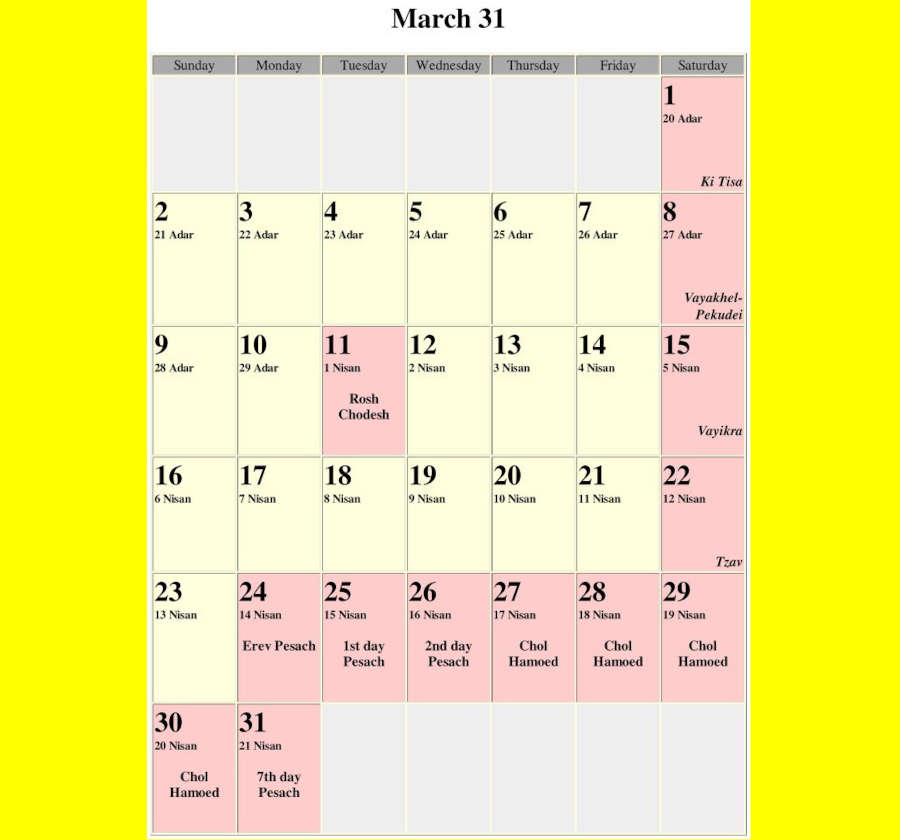 www.hebrewcalendar.net
www.hebrewcalendar.net
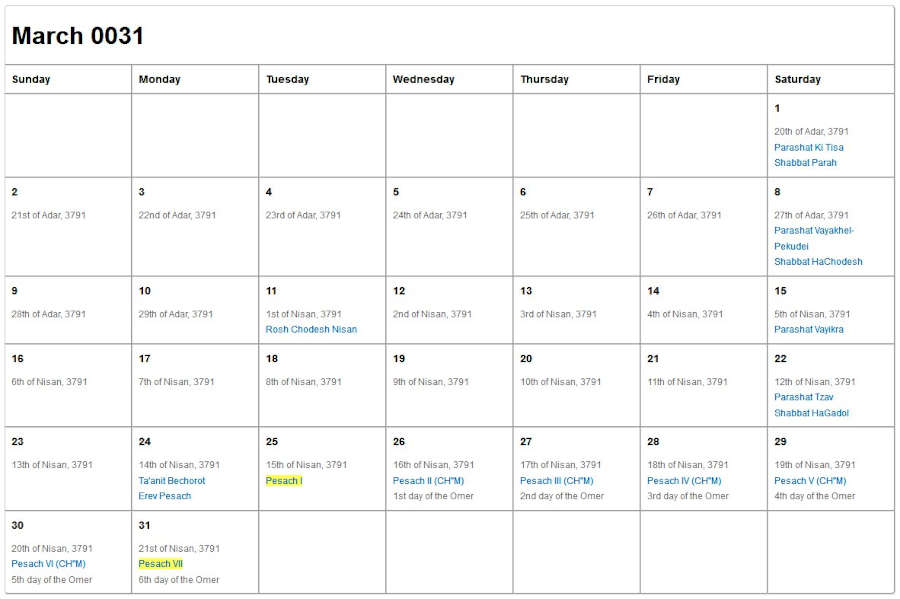 www.hebcal.com
www.hebcal.com
The third calendar I obtained is most likely without question and also states it is for the Julian calendar which would definitely be right for the
year 31 AD. Also the new moon dates stated are in agreement with other pages I have looked at.
But there are some very interesting observations that can be obtained from the above 2 calendars. And we look at them first.
The first point of interest is to note that neither of these two calendars give the date for the astronomical new moon. So how do we work these
calendars for the NT Bible Model if we don't have an astronomical new moon date? Actually this is not too hard but we have to make the assumption that all is
well with where the Jewish new moon day is sitting for this calendar month. If we make this assumption then the astronomical new moon date should
be approximately 1.5 days
before the Jewish new moon or first day of the Jewish month, which we can see from both calendars is Rosh Chodesh 1 Nisan on Tuesday 11 March.
Now I realise this date and week day are very much in question for this month but as I stated above we are still going to use this and see what
happens with the NT Bible Model approach. And providing all is well the NT Bible Model new moon worship day should be approximately 3 days before the
Jewish new moon day. So counting back 3 days brings us to Saturday 8 March. Now taking this as the first day of the Bible month we now count forwards
to get to the 14th day. Note that 14 Nisan is obtained by adding 13 to 1 and not 14. So we add 13 to 8 March and we obtain 21 March which is a Friday!
So using the NT Bible Model for new moon worship days we have indeed landed on a Friday for the crucifixion day.
The second point of interest is that this is indeed a Passover month. Some Christians believe that this
month cannot be a Passover month as it is not possible to obtain a Friday crucifixion date. Well if you have a close look at both of these Jewish
calendar
months you will see they have listed on Monday 24, Nisan 14 and state this is "Erev Pesach." That's Passover! see the following quotes. So both these
Jewish calendars are stating this is the Passover month. And the NT Bible Model was completely successful in getting to a Friday crucifixion date.
Pesach
Passover (Hebrew: Pesach) commemorates the story of the Exodus, in which the ancient Israelites were freed from slavery in Egypt. Passover begins
on the 15th day of the month of Nisan in the Jewish calendar, which is in spring in the Northern Hemisphere, and is celebrated for seven or eight days.
It is one of the most widely observed Jewish holidays.
http://www.hebcal.com/holidays/pesach
It might be a bit confusing to understand exactly when Passover begins, at least from a traditional Jewish point of view. Does it begin on Nisan
14 or Nisan 15? ...
Today the traditional Passover Seder begins on "Erev Pesach," meaning just before sundown on Nisan 14 and running into the first hours of Nisan 15
(outside of Israel a second seder is often held the following evening as well). ...
Unfortunately, most Jewish calendars refer to the previous evening as "Erev Pesach" without indicating that the first "day" of Passover spans
the end of Nisan 14 and carries over to Nisan 15.
http://www.hebrew4christians.com/Holidays/Spring_Holidays/Pesach/Zman_Seder/zman_seder.html
OK that's the fun stuff but to be honest there are a couple of problems. These two calendars are questionable and better authorities give the
astronomical new moon date as March 12. And this does mess up our above calculations. Firstly someone is going to say, wait a minute, the Jewish new moon
day is supposed to be on the day of the waxing crescent about 1.5 days past the astronomical new moon date. But the Jewish new moon day is given above
as March 11, and one day BEFORE the astronomical new moon. That's just not possible.
Actually it is. As stated above the Jewish calendar is constructed using a fixed length for the month whereas the true lunar synodic month length is not
fixed but approximate. As such some years the Jewish calendar gets out of sync with the moon and some Jewish new moon days can actually fall before
the astronomical new moon! 2013 was one such year and we refer you to the months of August and October.
The astronomical new moon days for these
months were 7 August and 5 October. These were also months that the Jewish calendar gave 2 consecutive new moon days. They do this every couple of months
or so because the actual lunar month is not an integer length meaning every few months their calendar needs an adjustment.
Anyway, the Jewish new moon days for these months were
given as 6 and 7 August, and 4 and 5 October. Now you can look at these dates as long as you want, but it can't be denied that two of these days
actually fell BEFORE the astronomical new moon for their month! So this could actually happen for the month we are looking at.
Does this help our above calculations? No it doesn't but this is just a matter of honesty. If we take the astronomical date for the above months as the
12th, then the NT Bible Model new moon day will be on the 10th, one and half days before. This also depends on the actual time of the astronomical new moon but let's suppose
we do get back to the 10th. Then adding 13 brings us to the 23rd and a Sunday, not a
Friday.
A fascinating mistake
I have made a very interesting mistake in the last calculation. I have correctly stated that better authorities give the
astronomical new moon date as March 12 but this is really for the Julian calendar and the two we looked at above are Gregorian based. So this
new moon date is most likely wrong for this calendar. And how do we find the correct date?
One web site I found suggested a difference of 2 days for
this year. But the working wasn't clear. Better yet I found a calculator to do this and put in the Julian date for the astronomical new moon and
the result returned was Monday the 10th of March. This date was basically what I suspected and hoped for as it sits very well with the Jewish
days given.
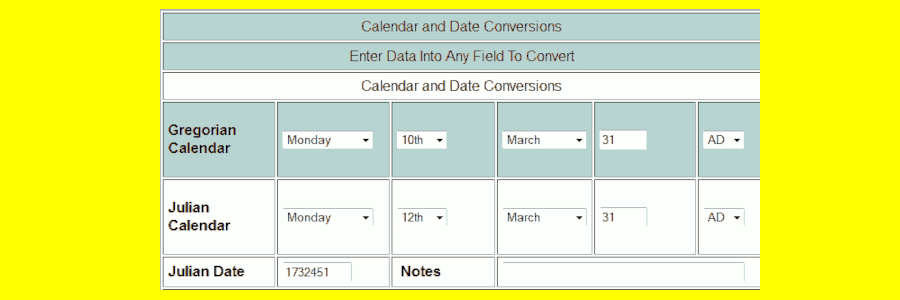 http://www.csgnetwork.com/julianmanycalconv.html
http://www.csgnetwork.com/julianmanycalconv.html
Note that for this calendar we now have Rosh Chodesh 1 Nisan given on Tuesday 11 March approximately 1.5 days after the astronomical new moon date. 1.5
days? Let's check that. Since the difference in these calendars is complete days it would be pretty safe to assume that the time of the astronomical
new moon would be close if not the same. We then take the new moon time as approximately 12:22am Jerusalem time [we mention this later with the
Julian calendar].
OK let's add 1.5 days and see how we go. From 10 March 12:22am 1.5 days brings us to 11 March 12:22pm. Well that's just in the afternoon and well
before sunset and using Bible reckoning for days this would be accepted as 11 March. And for this calendar Rosh Chodesh 1 Nisan is given as 11 March.
The method we have applied here is the NT Bible Model approach but taken forwards instead of backwards.
It's not exactly the same as the Jewish method of looking for the waxing crescent though they don't really do that any more but just use their
calendar which is constructed using a fixed length for the months with some added complicated rules for when days occur at curious times.
This we don't have to look at but for this calendar month it does show that the NT Bible Model approach has given a very good result.
And was the NT Bible Model new moon day previously obtained reasonable? We now have the correct astronomical new moon date and time for this calendar.
Let's see how it went. Subtracting 1.5 days from 10 March 12:22am we arrive at 8 March 12:22pm and the NT Bible Model new moon worship day and
first day of the Bible month will then be taken as Saturday 8 March. This is exactly the same date we obtained before and will give the proposed
crucifixion date as Friday 21 March as before.
OK time to move to the next calendar and we believe this one should be above question. The site states this calendar is Julian since it is for 31 AD:
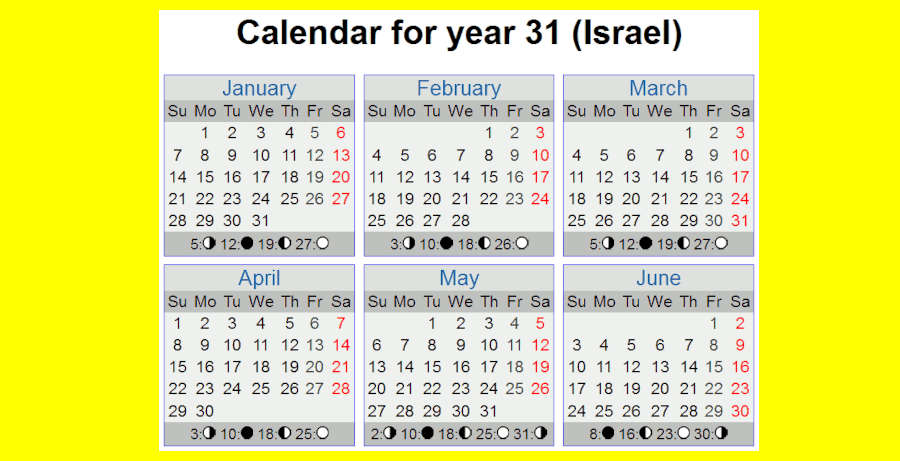 www.timeanddate.com
www.timeanddate.com
And this calendar does give us the date for the astronomical new moon and we will have absolutely none of the possible problems we encountered with
the previous two calendars. Further information from this same site also gives the astronomical new moon time as approximately 12:22am Jerusalem time.
The astronomical new moon date of 12 March is mentioned on a few different sites so we can most likely take it along with this calender as probably
without question.
At this point I also tried to get the astronomical date and time from NASA as a check and obtained the following:
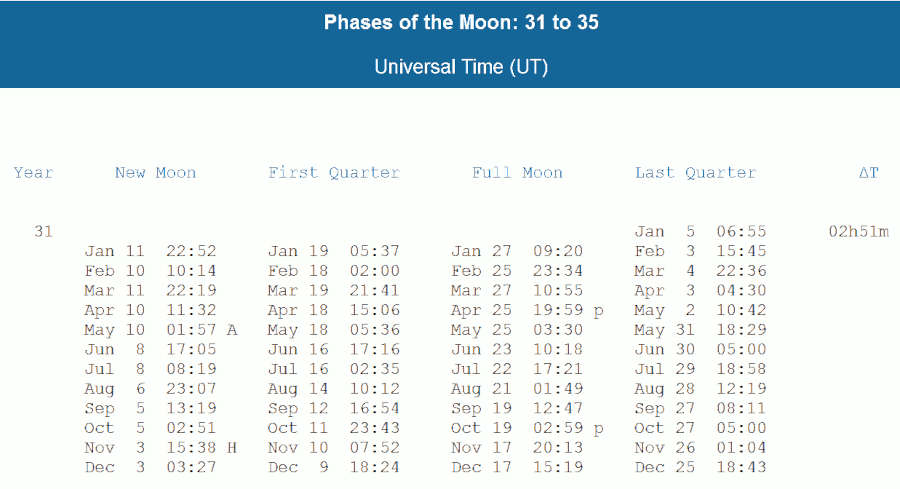 http://astropixels.com/ephemeris/phasescat/phases0001.html
http://astropixels.com/ephemeris/phasescat/phases0001.htmlPreviously found at
http://eclipse.gsfc.nasa.gov/phase/phases0001.html
The NASA page stated that the Julian calendar was being used for this year. The astronomical new moon time for March from this table is given as
11 March 22:19. That looks a little different to what the above site gave. Or is it?
The NASA table values are for UT or universal time which is stated elsewhere
to be the successor to Greenwich Mean Time. And to get to Jerusalem times we have to add 2 hours [GMT + 2 mentioned on my Search page] and we
obtain 11 March 24:19 which of course is 19 minutes into 12 March giving 12 March 12:19am. A discrepancy of 3 minutes. And definitely not
worth worrying about!
So we can try our adjustment with the NT Bible Model and see how we go. We don't need the Jewish calendar days for this month as the NT Bible Model
simply needs the astronomical new moon date and time. We have already decided from above that this is a Passover month. We can make that assumption
quite safely. Now let's find the NT Bible Model new moon worship day. Counting back 1.5 days from 12 March 12:22am we arrive at 10 March 12:22pm.
We then take 10 March as the NT Bible Model new moon worship day and the first day of the Bible month. Then adding 13 days we arrive at 23 March and it is a Friday!
So using the NT Bible Model we have arrived at Friday the 23rd of March 31 AD as a possible date for the crucifixion of Christ!
But see the Historical problems section below.
And this date sits reasonably well with the current approach for determining Easter!
In 325CE the Council of Nicaea established that Easter would be held on the first Sunday
after the first full moon occurring on or after the vernal equinox. From that point forward,
the Easter date depended on the ecclesiastical approximation of March 21 for the vernal equinox.
Easter is delayed one week if the full moon is on Sunday, which decreases the chances of it
falling on the same day as the Jewish Passover. The council's ruling is contrary to the
Quartodecimans, a group of Christians who celebrated Easter on the day of the full moon,
14 days into the month.
http://www.timeanddate.com/calendar/determining-easter-date.html
Historical problems
The main problem with this date is that it just doesn't work!
So what went wrong?
Well the calculations all look good [but see next paragraph] but it has been brought to my attention that a central point for all of this involves the full moon. Actually
no one mentioned this to me but in doing a little more reading I found a quote that stated that Jesus and the disciples should have noticed
a reasonable looking full moon on the Thursday night before the Friday crucifixion. Also this ties in with Nisan 14/15 being roughly half way through
the month and falling on or near the time of the full moon.
And another interesting point I have noticed is that the crucifixion day may actually
be Nisan 15 and not 14. This would add another day to our calculation giving Saturday the 24th of March instead of the Friday--a completely
unacceptable result!
The Passover begins on the 15th day of the month of Nisan, which typically falls in March or April of the Gregorian calendar. Passover is a
spring festival, so the 15th day of Nisan begins on the night of a full moon after the northern vernal equinox. To ensure that Passover did
not start before spring, the tradition in ancient Israel held that the first day of Nisan would not start until the barley was ripe,
being the test for the onset of spring. If the barley was not ripe, or various other phenomena indicated that spring was not yet imminent,
an intercalary month (Adar II) would be added. However, since at least the 4th century, the date has been fixed mathematically.
http://en.wikipedia.org/wiki/Passover
And as soon as this came together in my mind I immediately realised that:
- Neither of these two months in AD 31 look like supporting a Friday crucifixion. I was in the same hole my friend misunderstanding the Karaite Jewish quote was in;
- I finally had an answer as to which "new moon" day was correct: the beginning of the dark phase of the moon; the day of the astronomical new moon; or the waxing crescent? If Nisan 14/15 is roughly at the time of the full moon which is about 14.5 days into the month then the correct Biblical new moon worship day has to be the waxing crescent. Nomatter whatever else I had put together, that was the day!
And this is a reasonable follow-through I was interested in some years back. It may have been 2011; I had decided that if some special Bible date could be obtained that would verify a new moon day then this would give the answer. And this was the reason back then as to why I investigated the Friday crucifixion date. But the study didn't go anywhere and after some time I abandoned it... until now. And now I have an answer.
And so we come to...
The corrected study
We can use our models for the Biblical new moon worship day to search for the historical crucifixion date. It's generally agreed this would be on a Friday. There are a few christians who disagree but the Bible is pretty clear about this. Jesus was crucified on the preparation day [see Mark 15:37,42], the day before the sabbath [Saturday] so this places the crucifixion clearly on a Friday.
And Jesus uttered a loud cry, and breathed his last.
And when evening had come, since it was the day of Preparation, that is, the day before the sabbath,
Mark 15:37,42.
Finding approximate years for Jesus' death can be quite interesting. According to the Gospels He must have been somewhere around 33 years old but this is again possibly approximate. And we could also try to chase this from his birth year?
Most scholars generally assume the year of the birth of Jesus to be around 6-4 BC, though some widen the range to 7-2 BC, but there is no
definitive dating.
http://en.wikipedia.org/wiki/Anno_Domini#Historical_birth_date_of_Jesus
Scholars have provided estimates for the year of crucifixion in the range 30-33 AD, with the majority of modern scholars favouring the date
April 7, 30 AD.
http://en.wikipedia.org/wiki/Crucifixion_of_Jesus#Chronology
This last year range estimate sits well with us. Those following the 2300 day prophecy of Daniel generally arrive at 31 AD as the
possible crucifixion year though not all christians are in agreement with this. But it's basically where we are at and fits reasonably with the above
year range.
And without showing too much partiality if we work around this year it should satisfy most christians. The year 31 AD is a reasonable year for
the death of the Messiah according to Daniel's seventy weeks of years prophecy about the Messiah. So if we look at the 3 years 30, 31, and
32 AD we should be pretty close! The following quote also suggests this is close:
When was Passover in AD 30?
People who ask this question are normally trying to calculate the exact date of Jesus' death.
The New Testament states that Jesus died on a Friday at the beginning of the Jewish Passover, and that his resurrection took place on the
following Sunday. However, it is not quite clear if Jesus' death took place immediately before the start of the Jewish Passover or on the first
day of Passover. Since Passover starts on 15 Nisan, it is unclear if Jesus died on 14 or 15 Nisan.
This question is important for Christian historians because if you know the date, you may with some degree of confidence also calculate the year;
all you have to do is find a year near AD 30 where 14 or 15 Nisan fell on a Friday.
The problem is that we don't know the exact details of the Hebrew calendar as it was used in the first century. This means that we have to allow
for a margin of a day or two in the calculations, and this in turn means that we are left with quite a few possible dates.
Through the centuries several different dates for the crucifixion have been suggested. Currently, the most common theories suggest either
7 April AD 30 or 3 April AD 33.
http://www.tondering.dk/claus/cal/hebrew.php
The next step is to choose the new moon worship days that we will use. The waxing crescent is an obvious choice as this is the more general one
mentioned. A curious approach I worked out is to instead use the beginning of the dark phase of the moon as this should possibly be
following the Bible construct for a day. There is some question as to how to apply this to the moon but nevertheless the beginning of the dark phase is
a simple alternative to the waxing crescent.
The first one I saw was obviously the astronomical new moon on my wall calendar but as simple as this one is we may have to discount it as the majority
of historical quotes are saying that the Biblical new moon was originally observed. Well the beginning of the dark phase and the waxing crescent
were and are easily observed but the time of the astronomical new moon is not. Considering this it is unlikely to be the one we want so will just
focus on the other two.
How to apply the new moon worship day models
The numerical approach I worked out was to determine the new moon worship day as approximately 1.5 days from the astronomical new moon date. So do we use exactly 1.5 days from the astronomical new moon date for our models? Consider the following:
Long ago, the appearance of the new moon each month was attested by witnesses. Once their testimony was deemed credible, fires were set on the hilltops to announce the new month to neighboring communities who, in turn, passed the message along. This system proved both dangerous and cumbersome, and once Jews lived outside Eretz Yisrael, it was wholely inadequate.
The present Jewish calendar was introduced in the time of Hillel II (358/9 CE), at which time astronomical calculations replaced the practice of calling witnesses before the Sanhedrin. Since that time, it has been possible to calculate the Jewish calendar well into the future on the basis of scientific calculations.
Source: Rabbi Scheinerman's homepage
http://www.jewishvirtuallibrary.org/jsource/Judaism/Rosh_Chodesh.html
This is extremely curious and means that any of the Jewish calendars we obtained previously are most likely incorrect as they were probably generated
using current algorithms. So the present calendar constructions will only be valid back to 358/9 CE as mentioned in the previous quote.
However we should still be able to obtain reasonable astronomical new moon times and this means we can apply our new moon worship day models. And some more:
The molad is the time of the moon's "birth." There is a point in the moon's orbit in which it is positioned directly between the earth and the sun,
making it invisible to anyone standing on earth's surface. The molad occurs when the moon has moved far enough from this position that a thin
crescent of its illuminated surface becomes visible, marking the start of a new Jewish month.
... The actual moment at which the moon becomes visible will vary slightly from the average molad, depending on the relative positions of the
earth, moon and sun to each other at any given month, where on earth the observer is standing, the length of twilight at given seasons of the
year, and other astronomical variables.
For this reason the Jewish calendar is "tweaked" so that Rosh Chodesh -- the first of the month -- is as close as possible to the time in which
the moon would actually be seen in Jerusalem if we were still relying on actual observation of the moon to establish the start of a new month
(as was done until the 5th century C.E.). Also, because a month has to be made up of whole days, the Jewish month alternates between 29 and 30 days.
This is why Rosh Chodesh will often occur a day or more after the average molad.
http://www.chabad.org/library/article_cdo/aid/216238/jewish/Molad-Times.htm#notes
So trying to reconstruct a Jewish month in the early years of the first century we have to consider that the new moon worship days back then were
being determined visually and that this may mean they may have occurred a day or two later than an astronomical point for this would have given.
So if we add one day to our model approximations we should be pretty safe.
At this point we are now only looking at 2 models: the beginning of the dark phase of the moon, and the waxing crescent. The current model
approximation gives these at 1.5 days before and after the astronomical new moon date. Now allowing for our early century adjustment for a visual
sighting this will become 0.5 days before and 2.5 days after the astronomical new moon date. This should be acceptable and is definitely workable.
Now a little bit extra information before starting the year searches. The Bible states that Jesus is our passover sacrifice [1 Cor 5:7] so that should
place the crucifixion on Nisan 15 as this is the first day of passover as we have read above in some of the quotations. And this brings us to another
point that was missed in the previous study: at this time of the Jewish month pretty much half way through the month we would have a full moon.
This part of the study is going to use Nisan 15 as the day of the crucifixion. There appears to be a bit of controversy over this. See the Amendment at the end of the study for Nisan 14.
But it doesn't have to be on the actual day of the astronomical full moon. I think this point has been missed by many people searching for the date.
For the Jews doing a visual observation for the first day of the month there is some leeway. And also around the actual time of the full moon. For a
few days the moon looks pretty full. Any time around here would satisfy the passover constraint for a full moon.
And just one more point before starting. Since we are going way back before the current calendar constructions, the above Jewish calendar
constructions could also be wrong as to the Passover month. Consider the following [dated about 2008]:
So when is Passover this year? April 20th. But that's almost a month after Easter. How did that happen? Well 2008 is also a leap year in the
Jewish calendar. Because the calendar is moon-based (lunar) Jewish leap years are a big deal. A whole extra month is added this year before
Nisan can start. That moves this year's Pascal full moon into April. It doesn't affect the Easter calculation, though. Christians follow
Julius Caesar's solar calendar as amended by Pope Gregory, and only have a single February leap day to deal with. One final complexity,
Jewish days begin at sundown, so both April 20th and Passover begin on the evening of April 19th.
http://www.sciences360.com/index.php/astronomical-determination-of-passover-date-21518/
And one final point of interest to consider is the Vernal Equinox: for Jerusalem, the time when they considered it was officially "spring." The
Vernal Equinox for these years is given as:
30 AD 23 March
31 AD 23 March
32 AD 22 March
Note that the Vernal Equinox date for 31 AD puts the previous Jewish calendars in some question since their passover should possibly be well after
this date! And another curious thing to note is that the passover date in general is not necessarily at or near the first full moon after the equinox:
However, it wasn't enough for Passover to fall after the equinox, when it was "officially" spring; spring-like conditions needed to be evidenced.
If in the land of Israel the barley had not yet ripened, and the trees were not yet blossoming with seasonal fruit—that, too, was sufficient
reason to delay Nissan by adding a second month of Adar. Spring should be felt; it should be bright and green.
http://www.chabad.org/holidays/passover/pesach_cdo/aid/495531/jewish/How-Does-the-Spring-Equinox-Relate-to-the-Timing-of-Passover.htm
So there will be a little bit of leeway we can take when we look at these months in the years we are considering. And we now look at the 3 possible year candidates: 30, 31, and 32 AD.
30 AD
The Julian calendar we have obtained for this year is as follows:
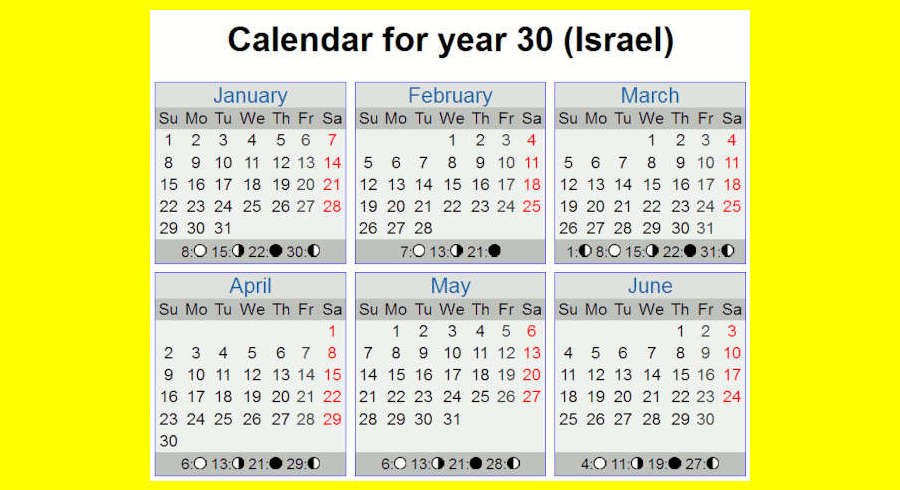 www.timeanddate.com
www.timeanddate.comWith the Vernal Equinox on March 23 we can see immediately that the passover date must be somewhere near the following full moon on April 6. For this year the Passover month must be April. Now let's try our models. To apply these we need the exact new moon date and time. The moon phase tables obtained are as follows:
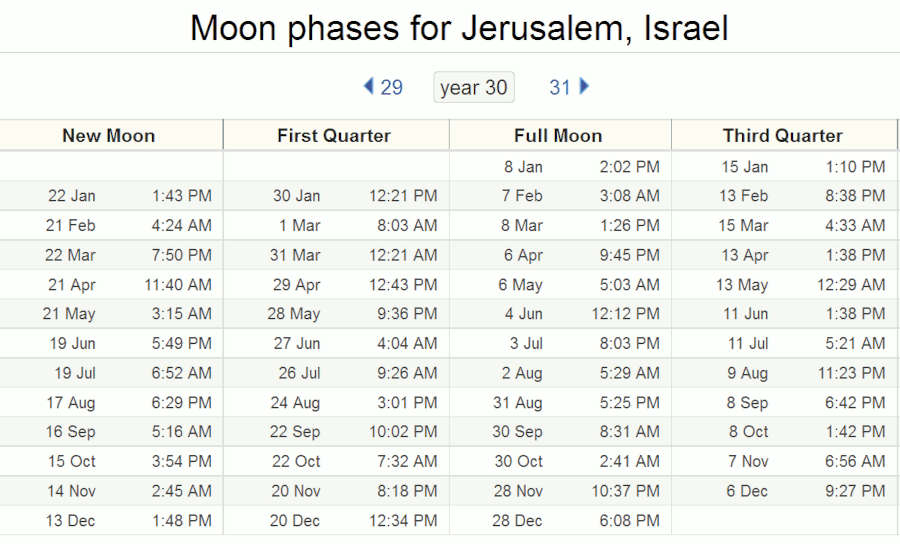 www.timeanddate.com
www.timeanddate.com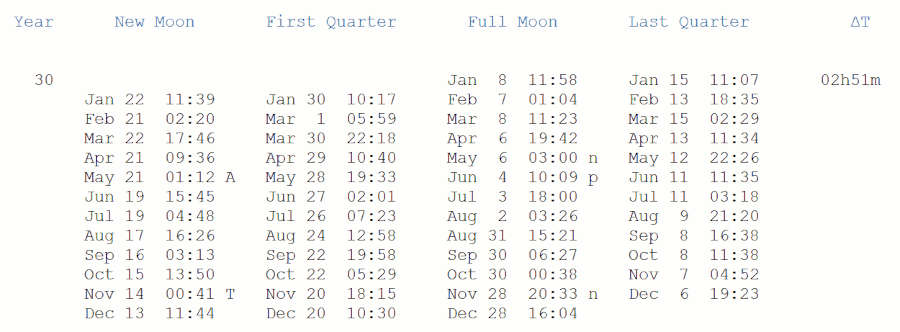 Previously found at
Previously found athttp://eclipse.gsfc.nasa.gov/phase/phases0001.html
Both sites state the dates given in these tables are for the Julian calendar.
We obviously only need the new moon time for March. The date is given as March 22. The NASA page gives 22 March 17:46 UTC and adding 2 hrs for
Jerusalem we arrive at 19:46 or 7:46pm which is pretty close to 7:50pm from the timeanddate site. It doesn't matter which one we use.
So now let's try our new moon worship day models.
For the beginning of the dark phase of the moon we subtract 0.5 days from 22 March 7:50pm bringing us to 22 March 7:50am. Using this as a possible
first day of the Jewish month we add 14 to arrive at Nisan 15 giving 5 April. It's pretty close to the full moon but it's a Wednesday and not a
Friday so this is not it.
For the waxing crescent visual approximation we add 2.5 to 22 March 7:50pm to obtain 25 March 7:50am giving March 25. Then adding 14 we arrive at
Saturday 8 April. Again, not a Friday so this also fails.
A summary of this so far would be:
Wednesday 5 April Beginning of dark phase of the moon
Saturday 8 April Waxing Crescent
We have used both our new moon worship day approximations for 30 AD and failed to find a Friday
Nisan 15 day so we move to the next year.
31 AD
The Julian calendar we have obtained for this year is as follows [showing months January-June]:
 www.timeanddate.com
www.timeanddate.com
With the astronomical new moon in March well before the Vernal Equinox on Mar 23 we may have to check this month as well as April. The moon phase tables obtained are as follows:
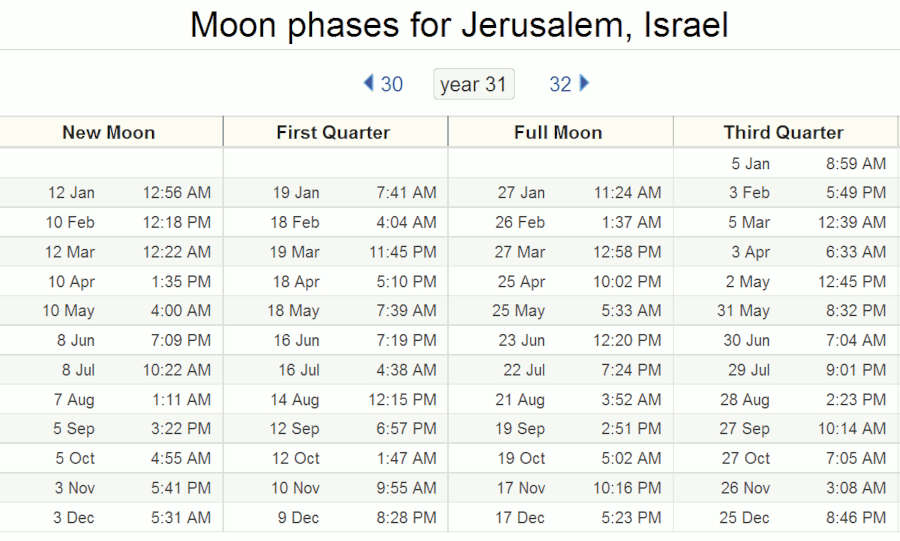 www.timeanddate.com
www.timeanddate.com
 http://astropixels.com/ephemeris/phasescat/phases0001.html
http://astropixels.com/ephemeris/phasescat/phases0001.htmlPreviously found at
http://eclipse.gsfc.nasa.gov/phase/phases0001.html
For March The astronomical new moon date is given as March 12. The NASA page gives 11 March 22:19 UTC and adding 2 hrs for
Jerusalem we arrive at 12 March 00:19 or 12:19am which is pretty close to 12 March 12:22am from the timeanddate site. It doesn't matter which one
we use. So now let's try our new moon worship day models.
For the beginning of the dark phase of the moon we subtract 0.5 days from 12 March 12:22am bringing us to 11 March 12:22pm. Using this as a possible
first day of the Jewish month we add 14 to arrive at Nisan 15 giving 25 March. It's not that far from the full moon but it's a Sunday and not a
Friday so this is not it. Also the date is only just past the Equinox and may suggest the next month for the passover.
For the waxing crescent visual approximation we add 2.5 to 12 March 12:22am to obtain 14 March 12:22pm giving March 14. Then adding 14 we arrive at
Wednesday 28 March. Again, not a Friday so this also fails. We have used both our new moon worship day approximations and failed to find a Friday
Nisan 15 day in March. We need to look at April.
For April the astronomical new moon date is given as April 10. The NASA page gives 10 April 11:32 UTC and adding 2 hrs for
Jerusalem we arrive at 10 April 13:32 or 1:32pm which is pretty close to 10 April 1:35pm from the timeanddate site. It doesn't matter which one
we use. Now let's try our new moon worship day models.
For the beginning of the dark phase of the moon we subtract 0.5 days from 10 April 1:35pm bringing us to 10 April 1:35am. Using this as a possible
first day of the Jewish month we add 14 to arrive at Nisan 15 giving 24 April. It's pretty close to the full moon but it's a Tuesday and not a
Friday so this is not it.
For the waxing crescent visual approximation we add 2.5 to 10 April 1:35pm to obtain 13 April 1:35am giving April 13. Then adding 14 we arrive at
Friday 27 April. This is indeed a Friday and we have a possible crucifixion date.
Also the full moon is given as Wednesday 25 April 10:02pm. This is late at
night so would be part of Nisan 14. Jesus and the disciples would have definitely seen something looking like a full moon on the following
Thursday night. Friday 27 April looks very promising. This looks like the answer and date we are looking for but we should still check 32 AD.
A summary for this year would be:
Sunday 25 March Beginning of dark phase of the moon
Wednesday 28 March Waxing Crescent
Tuesday 24 April Beginning of dark phase of the moon
Friday 27 April Waxing Crescent
32 AD
The Julian calendar we have obtained for this year is as follows [showing months January-June]:
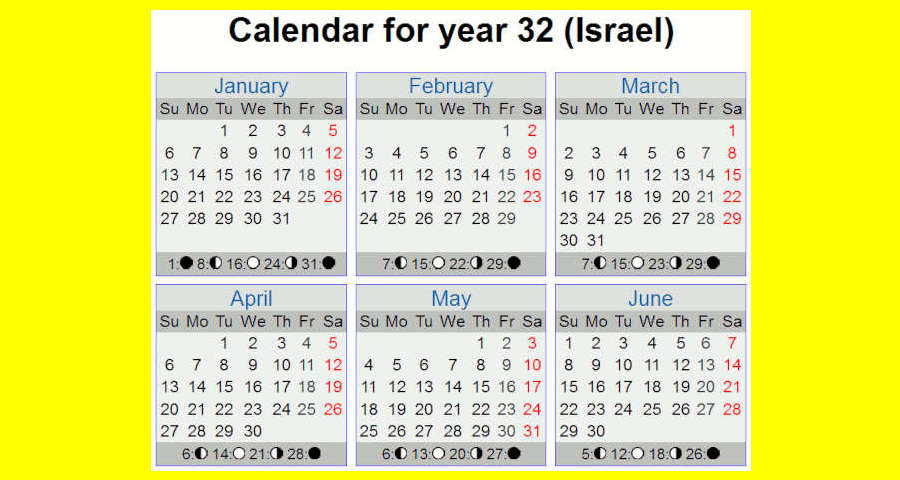 www.timeanddate.com
www.timeanddate.com
With the astronomical new moon on March 29 after the Vernal Equinox on March 22 we can see immediately that the passover date must be somewhere near the full moon in April. For this year the Passover month must be April. Now let's try our models. To apply these we need the exact new moon date and time. The moon phase tables obtained are as follows:
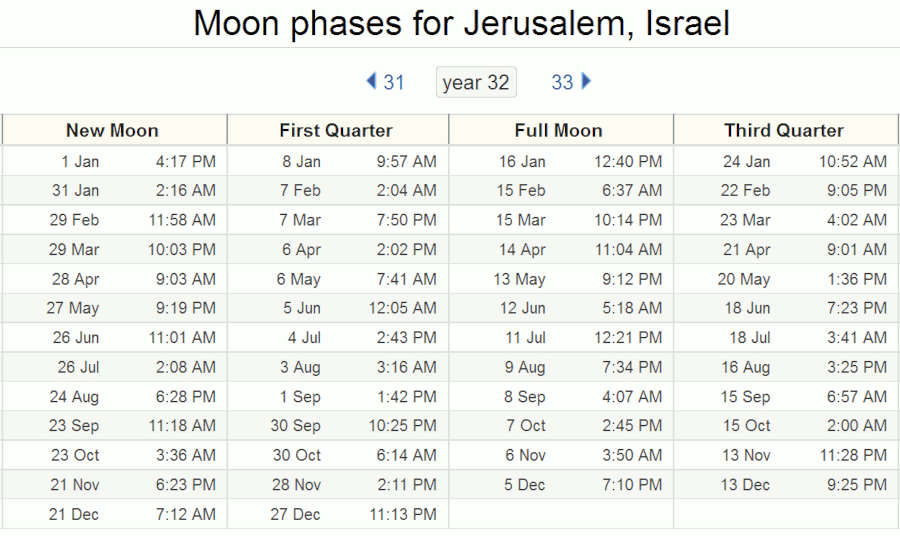 www.timeanddate.com
www.timeanddate.com
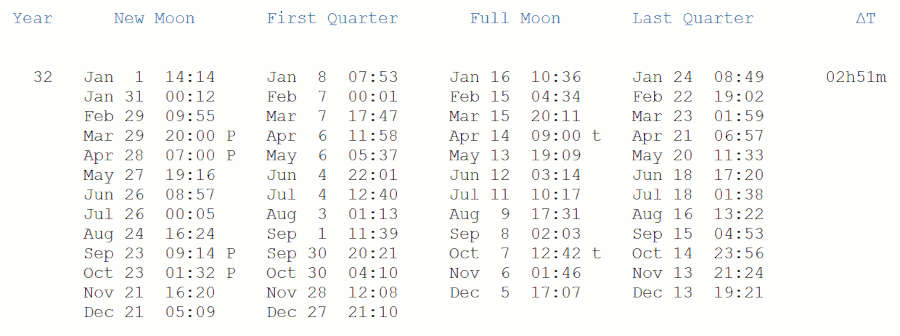 Previously found at
Previously found athttp://eclipse.gsfc.nasa.gov/phase/phases0001.html
We obviously only need the new moon time given near the end of March. The date is given as March 29. The NASA page gives 29 March 20:00 UTC and
adding 2 hrs for
Jerusalem we arrive at 22:00 or 10:00pm which is pretty close to 10:03pm from the timeanddate site. It doesn't matter which one we use.
So now let's try our new moon worship day models.
For the beginning of the dark phase of the moon we subtract 0.5 days from 29 March 10:00pm bringing us to 29 March 10:00am. Using this as a possible
first day of the Jewish month we add 14 to arrive at Nisan 15 giving 12 April. It's near the full moon but it's a Saturday and not a
Friday so this is not it.
For the waxing crescent visual approximation we add 2.5 to 29 March 10:00pm to obtain 1 April 10:00am giving April 1. Then adding 14 we arrive at
Tuesday 15 April. This is very close to the full moon date but again, not a Friday, so this also fails.
A summary of this so far would be:
Saturday 12 April Beginning of dark phase of the moon
Tuesday 15 April Waxing Crescent
We have used both our new moon worship day approximations and failed to find a Friday Nisan 15 date in 32 AD.
A full summary for our search using the two new moon models is as follows:

There is only one Friday date occurring in this table of search results. It is Friday 27 April 31 AD and was obtained using the NT Bible Model
approximating a visual sighting for the waxing crescent approach for the Biblical New Moon Worship Day. No Friday dates were obtained using the
Beginning of the Dark Phase of the Moon approach.
There are two very simple conclusions that can be drawn from these results:
- Friday 27 April 31 AD is highly likely to be the historical Crucifixion date
- The Waxing Crescent approach is most likely to be the correct historical New Moon Worship Day of the Bible
There still appears to be some controversy about just which day Jesus was crucified on—was it Nisan 14 or 15? And Christians appear to be divided on this point. For a Nisan 14 approach a simple solution would be to add an extra day [again] as mentioned in the above quote about rosh chodesh occurring one or more days after the molad. That would sort of solve the problem. Anyway I have given this some thought and we can proceed as follows so now we have an...
Amendment: Nisan 14
If Jesus was crucified on Nisan 14 what affect will that have on our results above? I have given this a little bit of thought and hit upon a very
novel solution. In fact I would expect someone to say, Stephen that just can't be right—it's just too simple. Is that it? I believe that people
have just been working too hard on this. Remember that some of this stuff is a bit loose. Remember that even though the Jews currently profess to
keep the waxing crescent approach you can still find Jewish calendar rosh chodesh days that fall before the day of the astronomical new moon.
Now consider
those quotes we looked at before about the Jewish calendar construction in the early centuries before Hillel II's calendar construction in about
358/9 CE:
This question is important for Christian historians because if you know the date, you may with some degree of confidence also calculate the year;
all you have to do is find a year near AD 30 where 14 or 15 Nisan fell on a Friday.
The problem is that we don't know the exact details of the Hebrew calendar as it was used in the first century. This means that we have to allow
for a margin of a day or two in the calculations, and this in turn means that we are left with quite a few possible dates.
http://www.tondering.dk/claus/cal/hebrew.php
The molad occurs when the moon has moved far enough from this position that a thin crescent of its illuminated surface becomes visible, marking
the start of a new Jewish month.
... The actual moment at which the moon becomes visible will vary slightly from the average molad, depending on the relative positions of the
earth, moon and sun to each other at any given month, where on earth the observer is standing, the length of twilight at given seasons of the
year, and other astronomical variables.
... This is why Rosh Chodesh will often occur a day or more after the average molad.
http://www.chabad.org/library/article_cdo/aid/216238/jewish/Molad-Times.htm#notes
The above writer has solved the problem for us: "all you have to do is find a year near AD 30 where 14 or 15 Nisan fell on a Friday." And allowing
for a visual sighting approach that the Jews would have been taking, in a
nutshell that's pretty much all there is to this. And we simply match this to our new moon models and we should have the answer!
So how do we do it? Well a good starting point is to take the lunar month length at approximately 29.5 days. The full moon will occur half way at
about 14.75 days and we would then expect the full moon to be approximately somewhere near day 15. And we can compare this with Nisan 14 or 15 for
the Jewish month but again this will depend on the new moon approach used.
For the beginning of the dark phase of the moon we are at about 1.5 days before the astronomical new moon but allowing for a visual sighting in the
early first century we have to allow that the beginning of the Jewish month could "occur a day or more after" when it should. Same for the waxing
crescent approach.
This means the
Jewish calendar month could start as late as the day after the astronomical new moon [using the beginning of the dark phase approach]. And Nisan
14 could fall as late as day 15 and the astronomical full moon. Here's a rough chart for when we could expect Friday [Nisan 14 or 15] to fall:

AST FM Astronomical Full Moon
BD Beginning of Dark Phase visual sighting approximately
WC Waxing Crescent visual sighting approximately
So for the Beginning of the Dark Phase approach we could expect Friday to be just before or on the Full Moon.
And for the Waxing Crescent approach we could expect Friday to be a few days past the Full Moon. Both of these approaches should work if we take
Friday as Nisan 14 [and pretty similar for Nisan 15]. Note at 29.5 days we would expect Nisan 14/15 to be right in the middle!
And so all we have to do is look at the three years and ask what do the months show us?
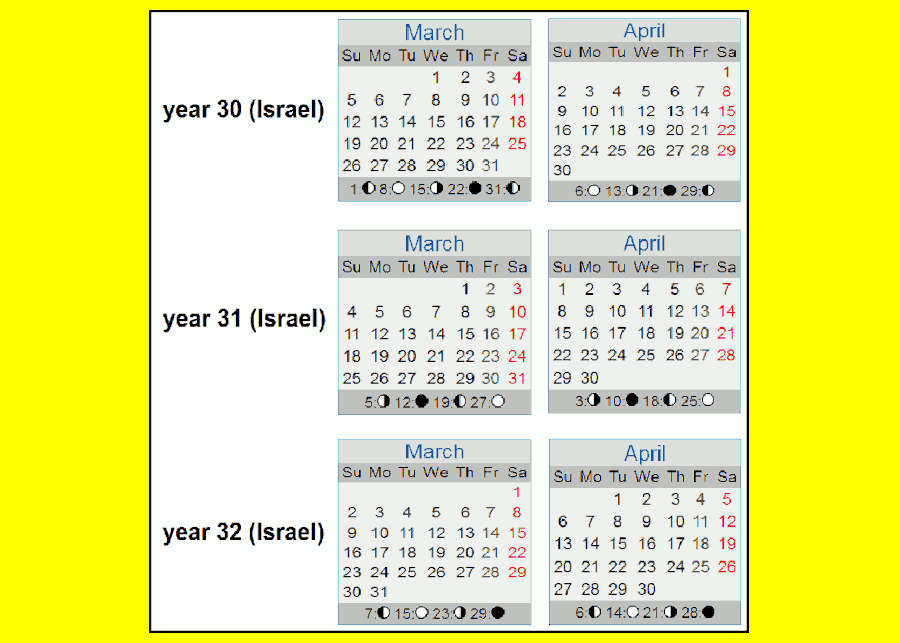 constructed from www.timeanddate.com
constructed from www.timeanddate.com
30 AD:
With the astronomical new moon on March 22 the Passover month must be April. The Full Moon is April 6 and one day before Friday. This Friday is
close but too early for the Waxing Crescent approach. Also it's a bit late for the Beginning of the Dark phase approach and again no match.
So we find no possible matches for 30 AD.
31 AD:
Full Moon on March 27 with Friday 3 days later. Friday after the Full Moon so no match for Beginning of the Dark Phase approach.
For Nisan 14 this is also a little late to be a match for the Waxing Crescent. Also the Full Moon date may be a little close to the Equinox
[23rd] to call this month a Passover month. Anyway no matches and we check April:
For April we have a Friday just 2 days after the Full Moon on the 25th. A Friday after the Full Moon so no match with the Beginning of the Dark Phase
approach. But it could match the Waxing Crescent approach. We then have a possible match for the Waxing Crescent approach on Friday 27 April.
32 AD:
New Moon on March 29 so only April is possible for a Passover month. The Full Moon is on Monday 14 April and is too late and too early for
either Friday so we have no matches for either approach.
Conclusions as before: we have one possible match for a Nisan 14 Friday and it is Friday 27 April 31 AD. And it was found using the Waxing Crescent
approach. No Friday dates were found using the Beginning of the Dark Phase approach.
So using astronomy and the NT Bible model to approximate a visual sighting approach that the Jews would have been using in the early years of
the first century we have arrived at Friday 27 April 31 AD for a Nisan 14 Friday giving a very possible date for the crucifixion!
Some curious closing comments
This just an afterthought—I decided to have a quick look out of curiosity at 33 AD as this is the other year given in the Scholarly range previously quoted:
Scholars have provided estimates for the year of crucifixion in the range 30-33 AD, with the majority of modern scholars favouring the date
April 7, 30 AD. Another popular date is Friday, April 3, 33 AD.
http://en.wikipedia.org/wiki/Crucifixion_of_Jesus#Chronology
Well in our study above we have already looked at Friday 7 April 30 AD. We didn't accept this date since this Friday is only one day after the
astronomical full moon and unlikely to be Nisan 14 if our study suggestion for how the Jews were using a visual sighting for the waxing crescent
to determine the first day of their calendar month is correct.
For this day to be a suitable Friday it had to possibly occur a couple of days after the astronomical full moon. So as good as it looks on
the calendar, it is quite possible that this date may not fit the historical evidence for how the Jews may have been constructing their
calendar in the early years of the first century.
So how about 33 AD?
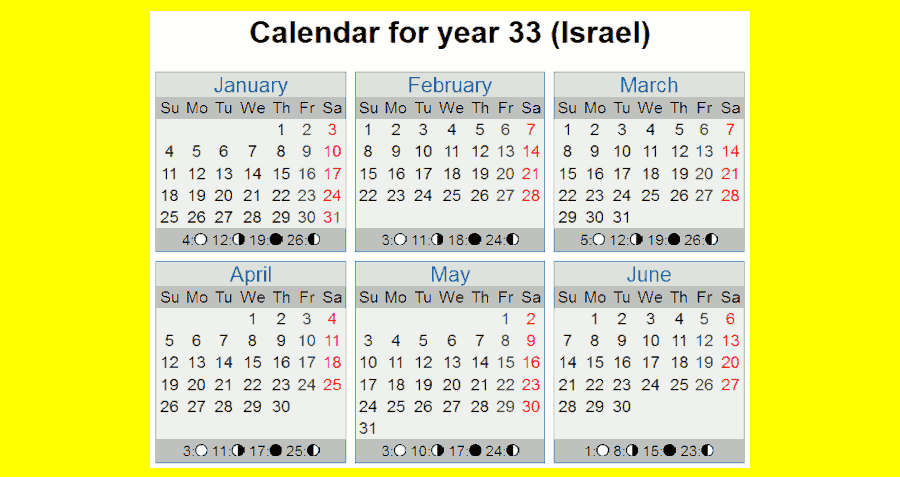 www.timeanddate.com
www.timeanddate.com
At this point in our study it would be fair to say we are now only looking at the Waxing Crescent approach. So again we need a Friday a few days after
the astronomical full moon. What have we got? The March new moon is on the 19th so the Passover month had to be April. And the full moon in April is
on a Friday. It is the 3rd and this is the date given in the quotes. But according to what we are suggesting in our study above it may be
unlikely that this date was Nisan 14 and an acceptable date for the crucifixion.
And this is extremely fascinating. These two dates, which are a couple of the generally accepted proposed dates for the crucifixion, 7 April 30 AD
and 3 April 33 AD, are not supported by the general visual sighting approach that the Jews would have been doing as we have
suggested in this study for the early years of the first century.
More interesting yet is the date we have found which we suggest is actually supported: Friday 27 April 31 AD.
Generally, Christians who have supported this date have taken a fair bit of flack from other
Christian groups who claim that the date cannot be supported and that these other dates are much more acceptable.
But according to how the Jews may have been constructing their calendar as we have suggested for these early years in the first century it
is possible that this story may very well be the reverse!
An added afterthought
Hey Stephen, someone may say, the 3 April 33 AD date has the Friday on the full moon and may actually support your alternative new moon day: the Beginning of the Dark Phase. I did notice that but decided at this point to take the safer approach. The weight of Jewish and historical quotes support the waxing crescent and the fact that we have found a Friday date using the waxing crescent does support this view. In short the simplest answer is most likely correct. And 33 AD has moved away from 31 AD although any of these years would be acceptable.
Historical reference
Were the Jews really constructing their calendar months by visual sightings in the time of Christ?
Answer: yes.
The history of the Jewish calendar may be divided into three periods—the Biblical, the Talmudic, and the post-Talmudic. The first rested purely
on the observation of the sun and the moon, the second on observation and reckoning, the third entirely on reckoning.
... Talmudic Period.
Under the patriarchate of Rabbi Judah I., surnamed "the Holy" (163-193), the Samaritans, in order to confuse the Jews, set up fire-signals at
improper times, and thus caused the Jews to fall into error with regard to the day of the new moon.
Rabbi Judah accordingly abolished the fire-signals and employed messengers. The inhabitants of countries who could not be reached by messengers
before the feast were accordingly in doubt, and used to celebrate two days of the holidays. By this time the fixing of the new moon according to
the testimony of witnesses seems to have lost its importance, and astronomical calculations were in the main relied upon.
... Post-Talmudic Period.
The persecutions under Constantius finally decided the patriarch, Hillel II. (330-365), to publish rules for the computation of the calendar,
which had hitherto been regarded as a secret science.
http://www.jewishencyclopedia.com/articles/3920-calendar-history-of
Clearly from these quotes the Talmudic period did not start until late in the second century. This means the time of Christ was clearly in the Biblical period of the Jewish calendar and its construction "rested purely on the observation of the sun and the moon."
Postscript
What about the news that scientists have used an earthquake to date the crucifixion as being on Friday 3 April 33 AD? Though we have discounted this date above as being extremely unlikely, this news does sound very interesting. However, reading the news articles actually reveals a completely different story!
In terms of the earthquake data alone, Williams and his team acknowledge that the seismic activity associated with the crucifixion could refer to
"an earthquake that occurred sometime before or after the crucifixion and was in effect 'borrowed' by the author of the Gospel of Matthew, and a
local earthquake between 26 and 36 A.D. that was sufficiently energetic to deform the sediments of Ein Gedi but not energetic enough to produce
a still extant and extra-biblical historical record."
May 24, 2012
http://news.discovery.com/history/religion/jesus-crucifixion-1205241.htm
Taken alone, geological research has identified a window from 26 to 36 A.D.
The research confirmed that two major earthquakes hit the area specified, one during the period between 26 BCE and 36 CE, and could be the
one referred to in the Gospel of Matthew.
However, the earthquake data alone doesn't fully confirm the date.
05/25/2012
http://www.huffingtonpost.com/2012/05/25/jesus-crucifixion-date-possible_n_1546351.html
So just how did they arrive at Friday 3 April 33 AD?
When data about the Jewish calendar and astronomical calculations are factored in, a handful of possible dates result, with Friday April 3, 33 A.D.
being the best match, according to the researchers.
http://news.discovery.com/history/religion/jesus-crucifixion-1205241.htm
And as we have previously mentioned, the actual calendar construction approach the Jews may have undertaken in the early years of the first century as we have suggested does not support this date. Further, this is just one choice of a few among Christians searching for the date. Or as the quote from wikipedia states:
There is no consensus regarding the exact date of the crucifixion of Jesus, although it is generally agreed by biblical scholars that it was on
a Friday on or near Passover (Nisan 15), during the governorship of Pontius Pilate (who ruled AD 26-36). Scholars have provided estimates for the
year of crucifixion in the range 30-33 AD, with the majority of modern scholars favouring the date April 7, 30 AD. Another popular date is
Friday, April 3, 33 AD.
http://en.wikipedia.org/wiki/Crucifixion_of_Jesus#Chronology
So when you read the articles, the news of the earthquake dating really has no impact on our suggested date of Friday 27 April 31 AD at all.
NOTES
The length of the lunar synodic month changes through the year and the Jewish calendar does not allow for this and actually can get a little out of
step.*
The Jews are aware of these length discrepancies and readily admit them:
JUDAISM 101
The Jewish Calendar: A Closer Look
Note that the calculated molad does not necessarily correspond precisely to
the astronomical new moon. The length of time from one astronomical new moon
to the next varies somewhat because of the eccentric orbits of the Earth and
Moon; however, the moladot of Rabbi Hillel's calendar are set using a fixed
average length of time: 29 days, 12 hours, and 793 "parts" (or in Hebrew,
chalakim). The amount of time is commonly written in an abbreviated form: 29d 12h 793p.
http://www.jewfaq.org/calendr2.htm
The NT Bible Model does not have this problem. The NT Bible model approach uses a numerical value to follow the astronomical new moon date. As the synodic month length changes through the year the position for the new moon worship day adjusts accordingly.
And contrary to the
Jewish version, the Bible New Moon worship day is a day for both
genders, not just women. The reasons for this are given in a
different study. See our Home page.
Also, according to
the Bible construction for a day, New Moon worship days are from sunset
to sunset.
The Jewish approach of
using two chodesh dates when the numerical value falls near a sunset
time is also taken. At present Jerusalem times are being used but the
reason for this is purely geographical, not Jewish. If the command
from God was given to Moses then it is clear the location is
somewhere near the region of Palestine. Using Jerusalem times should
solve any problem here.
* It got completely out of step in 2013. This was one of those out-of-sync years. See the PostScript section at the end of my Search page.
Companion pages
The Search for Chodesh [The New Moon worship day]



